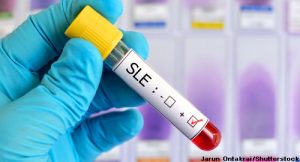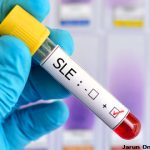 EULAR 2024 (VIENNA)—In the 18th Century, Queen Anne of England was one of the most famous people with what we now understand to be systemic lupus erythematosus (SLE) and antiphospholipid syndrome (APS). All but one of her 17 pregnancies ended in miscarriage, stillbirth or infant death before she died at age 49.1
EULAR 2024 (VIENNA)—In the 18th Century, Queen Anne of England was one of the most famous people with what we now understand to be systemic lupus erythematosus (SLE) and antiphospholipid syndrome (APS). All but one of her 17 pregnancies ended in miscarriage, stillbirth or infant death before she died at age 49.1
More than three centuries later, the EULAR 2024 session Systemic Lupus Erythematosus in 2024: What Is on the Horizon? offered fresh insights into the most cutting-edge research on SLE. The lecture was presented by Laurent Arnaud, MD, PhD, full professor of rheumatology at the Department of Rheumatology, University Hospitals of Strasbourg and French National Reference Center for Rare Autoimmune Diseases, France.
SLE Trends
Dr. Arnaud began by discussing the global prevalence of disease, which is estimated to be about 44 cases per 100,000 patient-years—meaning approximately 3.4 million people worldwide have SLE.2
Thankfully, SLE’s survival rate has increased, with a five-year survival rate of 53% in 1955 increasing to a 10-year survival rate of greater than 90% in 2020. However, the standardized mortality ratio for adult-onset SLE remains high, at 2.2, compared with the general population. This ratio is higher in patients with juvenile-onset SLE at 7.2.3 These ratios mean that patients who develop SLE as an adult (i.e., after age 16) have a death rate more than two times that of the general population. This rate is more than seven times that of the general population in people who developed SLE younger than 16 years old.
Diagnostic delay remains a persistent problem for patients with SLE, noted Dr. Arnaud, resulting in damage from untreated disease and from exposure to such treatments as corticosteroids.
More must be done to decrease diagnostic delay and improve the prognosis for patients with SLE, said Dr. Arnaud. Many disruption points exist in the standard pathway from symptom evaluation to diagnosis, such as undertraining of physicians on SLE, lack of adequate referral strategies for patients with positive anti-nuclear antibody (ANA) results and a dearth of access to SLE care coordinators, such as specialized nurses.
Improving Prognosis
Dr. Arnaud said patient prognosis may benefit from an enhanced and evolving understanding of genetics. Through genome-wide association studies (GWAS), more than 100 genetic loci have been associated with SLE.
In 2020, Reid et al. genotyped patients with SLE (1,001 in a discovery cohort and 5,524 in a replication cohort) and healthy controls (2,802 in a discovery cohort and 9,859 in a replication cohort) using a 200K Immunochip single nucleotide polymorphism array. A genetic risk score was calculated for each patient using 57 SLE risk loci. The study found that a high score was associated with early onset SLE, increased organ damage, cardiovascular disease, end-stage renal disease and decreased survival.4
Additionally, Dr. Arnaud noted that big data, such as artificial intelligence, machine learning and text mining, will undoubtedly play a role in improving early and accurate diagnosis of disease and predicting the risk of complications for individual patients. In 2021, Adamichou et al. published research on the SLE Risk Probability Index (SLERPI), a clinician-friendly algorithm for aiding SLE diagnosis developed using machine learning techniques.5
Technology is quickly helping improve diagnostic studies in the realm of image recognition software. This includes deep learning-based smartphone platforms that can detect features consistent with cutaneous lupus erythematosus, as well as automated classification systems that use uploaded images of ANA-HEp-2 cell immunofluorescence stains to identify the correct pattern for the ANA.
Treat to Target
Treat-to-target strategies must be rigorously evaluated as a potential means to improve patient outcomes, according to Dr. Arnaud. The first research into using a treat-to-target approach to manage patients with SLE was published in the early 2010s, with many more such studies emerging since.
The concept of treat to target comes from the fields of cardiovascular medicine and diabetes management. It involves setting a target, employing a treatment and then measuring if the target is achieved. For SLE, several questions arise regarding treat to target, including:
- What is the optimal treatment target for SLE?
- How often should we check if the target has been reached?
- What should we do after the target is achieved, and when it is not achieved?
According to Dr. Arnaud, the best target is disease remission, which is associated with lower risks of damage, cardiovascular events and death. Remission also correlates with improved quality of life, the prevention of disease flare and glucocorticoid discontinuation.6
However, Dr. Arnaud noted that a plan B is needed in case disease remission cannot be achieved. This backup plan may be achieving a lupus low disease activity state (LLDAS). The LLDAS is characterized by the absence of activity in major organ systems, a prednisone dose of no more than 7.5 mg per day and standard maintenance doses of immunosuppressive treatments.7
LLDAS can best be thought of as a “transition state.” In Dr. Arnaud’s view, we should not desire achieving this state. Among other concerns, the glucocorticoid dose remains too high to be acceptable in the long term. Rather, we should recognize that patients may need to reach this state before moving toward disease remission.
Pulse Therapy
In recent years, the treatment options for patients with SLE have expanded. However, the question about what to do with respect to corticosteroids, including pulse therapy, for these patients remains.
Dr. Arnaud cited an observational study from Ruiz-Irastorza et al. that evaluated more than 230 patients with SLE, assessing prolonged remission during five consecutive yearly visits. The authors found that methylprednisolone pulses administered in doses of 125 mg, 250 mg or—in severe cases—500 mg daily for three consecutive days to patients with SLE during the first year of disease were associated with a higher frequency of prolonged remission. This effect was mainly observed in patients with moderate to severe disease activity. Additionally, the use of such pulses was associated with reduced doses of prednisone given to patients with a baseline Systemic Lupus Erythematosus Disease Activity Index 2000 (SLEDAI-2000) score ≥6.8
More work needs to be done on this subject, but Dr. Arnaud indicated that these results—if reproducible—may support the intermittent use of pulse therapy over the prolonged use of oral glucocorticoids.
In Sum
Dr. Arnaud covered a tremendous amount of ground in 30 minutes. As we look to the horizon, it’s clear that many exciting innovations lay ahead to help patients with SLE achieve healthier and longer lives.
Jason Liebowitz, MD, is an assistant professor of medicine in the Division of Rheumatology at Columbia University Vagelos College of Physicians and Surgeons, New York.
References
- Weissmann, G. Queen Anne’s lupus: Phospholipids and the course of the Empire. FASEB J. 2014 Apr;28(4):1527–1530.
- Tian J, Zhang D, Yao X, et al. Global epidemiology of systemic lupus erythematosus: a comprehensive systematic analysis and modelling study. Ann Rheum Dis. 2023 Mar;82(3):351–356.
- Moe SR, Haukeland H, Brunborg C, et al. Persisting mortality gap in systemic lupus erythematosus; a population-based study on juvenile- and adult-onset SLE in Norway 1999–2022. Rheumatology (Oxford). 2023 Sep 28:kead519.
- Reid S, Alexsson A, Frodlund M, et al. High genetic risk score is associated with early disease onset, damage accrual and decreased survival in systemic lupus erythematosus. Ann Rheum Dis. 2020 Mar;79(3):363–369.
- Adamichou C, Genitsaridi I, Nikolopoulos D, et al. Lupus or not? SLE Risk Probability Index (SLERPI): A simple, clinician-friendly machine learning-based model to assist the diagnosis of systemic lupus erythematosus. Ann Rheum Dis. 2021 Jun;80(6):758–766.
- Parra Sánchez AR, van Vollenhoven RF, Morand EF, et al. Targeting DORIS remission and LLDAS in SLE: A review. Rheumatol Ther. 2023 Dec;10(6):1459–1477.
- Franklyn K, Lau CS, Navarra SV, et al. Definition and initial validation of a Lupus Low Disease Activity State (LLDAS). Ann Rheum Dis. 2016 Sep;75(9):1615–1621.
- Ruiz-Irastorza G, Paredes-Ruiz D, Herrero-Galvan M, et al. Methylprednisolone pulses and prolonged remission in systemic lupus erythematosus: A propensity score analysis of the longitudinal Lupus-Cruces-Bordeaux inception cohort. Arthritis Care Res (Hoboken). 2024 Mar 26. Online ahead of print.

